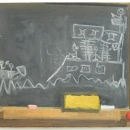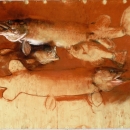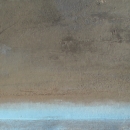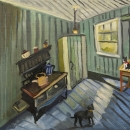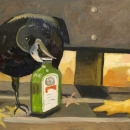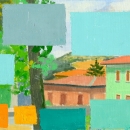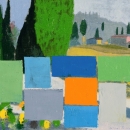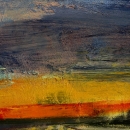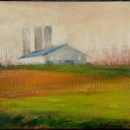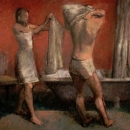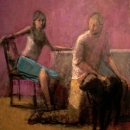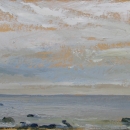May 3 – June 15, 2013
Essay by John Goodrich
At a glance, painting “realistically” and painting from observation might seem like one and the same process. The two, however, are based in very different expectations of art. A “realistic” image confirms what we already know: the way we’ve synthesized countless sightings of buildings, people, trees and so on, and then arranged them in evocative ways. But when painters work from observation—truly seeing what nature presents, instead of what they expect to find—they bring to us a deeper accounting of the world. We find nature’s peculiarities—the contradictions of a certain illumination, or of a point of view, or the way tiny nuances reveal (before we’re even aware of it) that a surface turns in light or recedes in space. In short, we experience a portrait, rather than the idea, of nature. Long ago, in early childhood, we all became adept at recognizing things—everything from a familiar face to its abstracted descendant, a smiley icon—but it is the artists among us who have acquired the habit of seeing things in all their unpremeditated glory.
The nine artists represented in “From Observation” remind us of what it means to see truly, and moreover that all painters find their own truths. If landscape represents the marriage of earth and sky, the landscape artists in this group choreograph the union in different ways. For instance, working in encaustic, Paula Stark captures in vivid colors the loneliness of farm buildings under pale skies. In John David Wissler’s oil paintings of shorelines, skies take on a luminous vastness, with clouds radiating and weaving over receding planes of water. William Kocher’s darker, more expressionistic landscapes place silhouettes of trees—hazy, yet resolute—against glowing bands of deep ultramarine, light green, and flaming red.
Observation entails an ordering of perceptions, and necessarily a certain amount of subjectivity. Some paintings in the exhibition deliberately blur the line between faithful rendering and invention. Bordering on the abstract, Eric Golias’ small oil paintings turn the landscapes into broad, primal gestures of contrasting hues and tones. Mitchell Johnson’s stylized landscapes take abstraction in a different direction, balancing simplified houses and trees with rectangles of pure color. In his dynamic images, objects grow out of forms as much as forms grow out of objects.
The landscape may provide the ultimate opportunity for grand sweeps of light and space, but other subjects contain their own dramas. Jeff Geib explores a more intimate aspect of nature, focusing on an eerie scene of piled fish; his charcoal drawings combine a delicate, atmospheric richness with a robust touch that leaves his fingerprints and thumbtack imprints in full view. Michael Allen’s large canvas of a kitchen interior explores another kind of intimacy. Reflected in a window, his own likeness appears behind a row of household objects on a window sill, each deftly captured in its own glassy, matte, or leafy texture.
In a sense, every painting based on observation tells a story: the way a cloud overhangs a patch of earth, or a vase occupies a shelf. In some paintings, the narratives assume a decidedly human dimension. Limbs and torsos lean and twist in deliberate rhythms in Mark Webber’s figure compositions, all towards the end of authenticating human gesture; in his large canvases, observed movements turn into earnest interactions, as a woman offers a towel to a bather, or a man grooms a dog. Mark Heyer’s radiant, folk art-like scenes aren’t necessarily populated by people, and yet a sense of human wonder suffuses his painting of an out-of-perspective kitchen, with a dog and cat eyeing each other across clunky floorboards.
“Paint what you see, not what you know”— engrained into generations of art students, this edict sounds simple enough, but it summarizes the constant challenges and possible triumphs for any painter. One of the great rewards of “From Observation” is witnessing the ongoing commitment of these nine artists to the observed world. Their approaches range from traditional representation to expressionism, with hints even of Magic Realism and Cubism. Connecting their work, however, is something that lies beyond style: the tensions and peculiarities of the visual world, as only the eye can absorb them.

